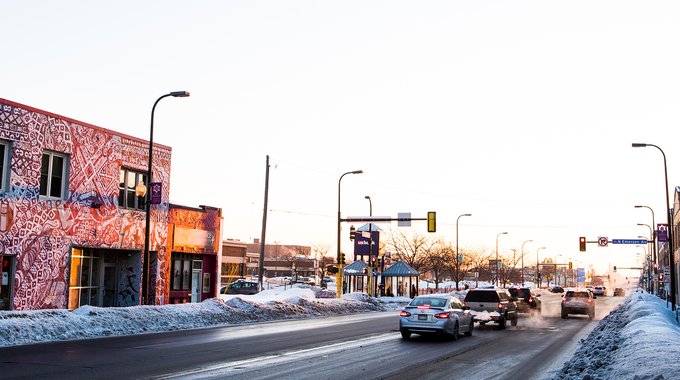Emerson & West Broadway: A Community Crossroads
The intersection of Emerson and West Broadway in North Minneapolis is a crossroads of opportunity. EMERGE and Cookie Cart on one corner. Across the street: Urban Homeworks and Juxtaposition Arts. On the opposite corner you’ll find the West Broadway Business and Area Coalition. And though their Twin Cities office is across the river in St. Paul, the Local Initiatives Support Corporation (LISC) is deeply woven into the fabric of this neighborhood and continues to invest in its physical and economic well-being.

At a glance, this intersection may look like many others in North Minneapolis. But what you don’t see from just driving through are the opportunities created by each of the organizations that anchor this hub. Financial literacy training. Job opportunities. Stable housing. Youth development. Celebration of art and culture. The opportunity to thrive.
These opportunities embody the key pillars of LISC’s community development philosophy: physical and economic development, and social impact. LISC has partnered with and invested in the organizations at this intersection with the belief that when a community believes in itself, community members can create lasting change and thrive in a place that they love.

When LISC began partnering with various organizations in the Emerson and West Broadway neighborhood, there was already a lot of community-driven vision and activity happening says Tina Homstad, a Program Officer at Twin Cities LISC. LISC was able to get behind those projects, people and organizations to help support their vision—through financial support, technical expertise, network building and so much more.
“It’s really about putting the community first,” Homstad says.
Building More Sustainable Households
Take, for example, EMERGE—one of LISC’s Financial Opportunity Center and Bridges to Career Opportunities partners, helping individuals and families achieve financial stability. EMERGE, with support from LISC and many others, redeveloped the historic North Branch library into their North Minneapolis headquarters—and a hub for their workforce development programs, where they offer individual job coaching, financial education workshops, and connections to technical training and career opportunities.
Mike Wynne, executive director of EMERGE, says that the Bridges to Career Opportunities partnership ties career training to financial education and asset building. “The data suggests that people achieve better outcomes when they receive these two ways of support—a training program standing alone is not as powerful as a training program with financial education.” This dual vision helps people create and commit to a vision for their future—one that’s not just about survival or a singular career goal, but a plan that leads to greater accomplishment.
“We believe that if we can help more people gain access to jobs and increase income, and also help people develop financial skills, that they’re going to become more sustainable households,” says Wynne. With this help, “they’re going to be able to pay their cost of living and they’re going to invest in their own community, and our community is going to thrive together. That’s our notion of community development.”

Connecting Neighbors Through People-Oriented Development
Urban Homeworks, on the opposite corner of Emerson and West Broadway, has a two-pronged focus: community engagement and housing.
LISC has partnered with Urban Homeworks to support them as they’ve grown by helping build organizational capacity, offering technical assistance, facilitating conversations with other organizations, and helping them learn how to better tell their organization’s story. Urban Homeworks has also been a critical partner in LISC’s housing and foreclosure recovery work.
Urban Homeworks operates under a people-oriented development model. Using this model, they transform foreclosed, condemned or boarded properties into dignified, quality places to live. The people-oriented side comes in as they engage community members throughout the redevelopment process to help determine what their neighborhoods look like. What results is a network of high-quality rental units, opportunities for stable homeownership in improved properties, deeply engaged caretakers and connected neighbors.

Chad Schwitters, executive director of Urban Homeworks, says they’re re-imagining ownership, community control and how capital works for people in this neighborhood. “I'm excited to be a part of a community that develops itself from the inside out and embraces, includes, and builds on the power and energy within the people already here.”
It’s an opportunity to plug into a community, to have a voice, to contribute. In Schwitters’ view, when a community member benefits from the work, ownership, maintenance, and occupancy of a neighborhood, it’s the difference between housing being used to marginalize and divide a community or it being used as a redemptive, humanizing and equitable force.
Who owns the dirt?
Amy McCulloch, the deputy director of Twin Cities LISC, says an important question to ask when redeveloping a neighborhood is, “Who owns the dirt?”
Are they benefiting from the changes? The LISC team believes this is part of why the redevelopment of the Emerson and West Broadway neighborhood has been so successful—because the key organizations that “own the dirt” in the neighborhood have a vested interest in the success of its residents and businesses.
“We believe that the answers are here,” says Wynne. “We believe that the community has the assets and the resources to create the vitality and the economic opportunity to build the economic engine.”